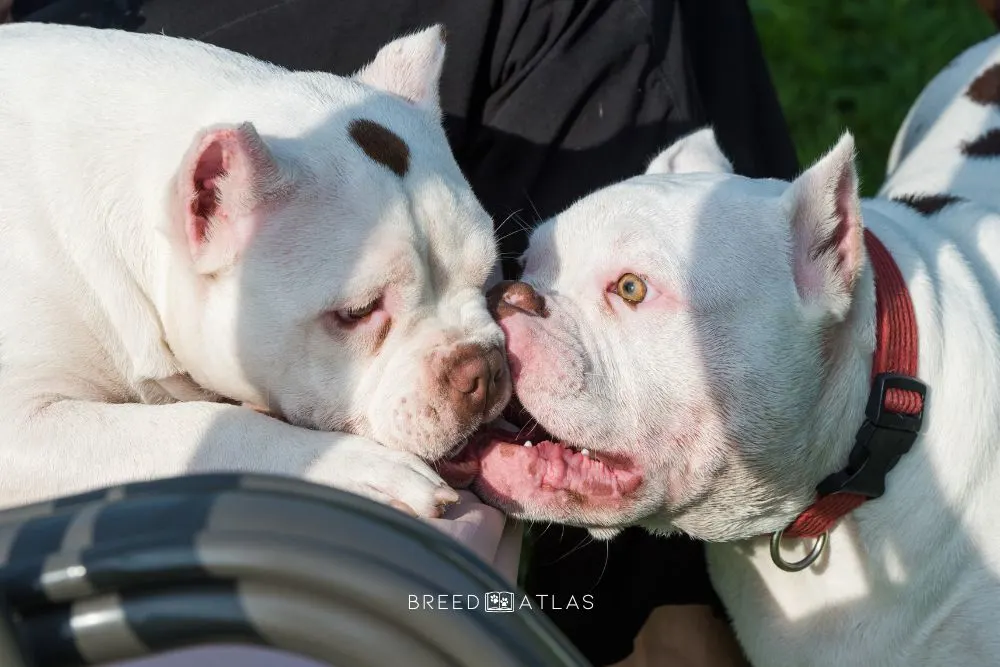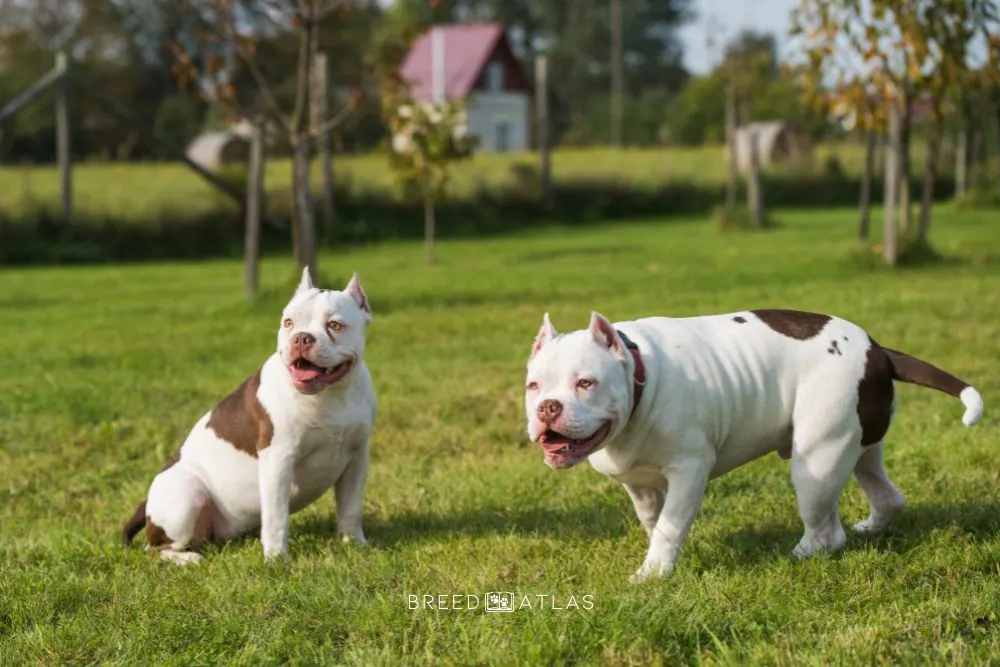Hey there, wondering how to treat American Bully skin problems?
If you’re a dog lover, you know that the breeds of dogs like American Bullies can sometimes need a little help in keeping their skin looking nice and healthy.
These muscular yet incredibly affectionate companion dogs come with their own quirks and needs, especially regarding their skin. Itchy patches, bacterial infection, or a dreaded belly rash can frustrate you and your Bully.
But fear not! This guide is your go-to resource on how to tackle American Bully skin issues, ensuring your dog’s coat stays as healthy and gleaming as their vibrant personality.
1. Medicated Shampoos And Topicals
One of the first lines of defense against skin problems in American Bullies includes medicated shampoos and topical treatments.
These products are formulated to address various issues, from fungal infections, skin fold dermatitis, bacterial infections, and canine atopic dermatitis to skin allergies, intertrigo, and inflammation.
Choosing a shampoo targeting your dog’s specific condition is crucial. That can range from a general anti-itch formula to something more specialized for conditions.
With that said, here is a brief list of ingredients that are usually found in topical shampoos for treating common American Bully skin problems:
- Chlorhexidine is a disinfectant and antiseptic ingredient used to combat bacterial skin infections. It helps reduce bacteria on the pup’s skin’s surface, minimizing the risk of infection.
- Miconazole is an antifungal component that is effective against yeast and fungal infections. It disrupts the cell walls of fungi, leading to their destruction.
- Ketoconazole is similar to miconazole, and it is also an antifungal agent used to treat infections caused by fungi and yeasts. It works by interfering with fungal cell membrane formation, leading to fungal cell death.
- Salicylic Acid acts as a keratolytic, helping to exfoliate the skin by causing the cells of the epidermis to shed more readily. It’s helpful in treating conditions like dandruff and seborrhea in humans! It makes the skin look shiny and healthy.
- Benzoyl Peroxide has antibacterial properties and is often used to treat acne in humans. In dogs, it’s used for its effectiveness against demodectic mange and folliculitis by oxygenating the skin and killing the opportunistic bacteria in hair follicles.
- Tea Tree Oil is known for its natural antimicrobial and antifungal properties, and it can be found in some dog shampoos. However, it must be used cautiously, as it can be toxic to dogs in higher concentrations.
Topical treatments, however, can range from spot-on medications to creams and sprays designed to address specific skin issues in the American Bully dog breed.
Frequency Of Use

The frequency with which you should use medicated shampoo varies depending on the specific skin condition and the product’s formulation. Always start with your veterinarian’s recommendation.
Some conditions may require weekly baths, while others require less frequent applications.
Pay close attention to the label or the instructions provided by your vet.
Some topical shampoos are designed for more frequent use. In contrast, others contain more potent ingredients for less frequent application to avoid potential side effects.
Application Techniques
When bathing your Bully with specialized shampoo, make sure to work the product into a lather that covers the entire affected area and surrounding regions. This means that the medication can act on the skin and hair follicles where problems might be brewing.
Let it sit long enough! One common mistake is rinsing the shampoo off too quickly. Many medicated shampoos must remain on the skin for a certain period (usually 5 to 10 minutes) to be effective.
This contact time allows the active ingredients to penetrate the dog’s skin and exert their therapeutic effects. Make sure to read and follow the instructions on the packaging.
As for topical treatments, apply a cream or spray as directed to affected areas, following your vet’s instructions regarding quantity and frequency.
Monitor your pup after application to make sure he doesn’t lick off the medication (this is very likely to happen if the affected area is within his reach). Try using an Elizabethan collar (e-collar) as it can help prevent this. Be careful as it can also be stressful to the dog.
Drying The Skin Properly
After rinsing the shampoo thoroughly, it’s essential to dry your Bully’s skin gently but thoroughly.
Use a soft towel to pat the dog’s skin dry rather than rubbing it. Watch out; rubbing the towel against the dog’s sensitive skin can cause irritation.
In areas with skin folds or where the coat is denser, take extra care to remove as much moisture as possible. Excessive moisture is a no-no as it provides an ideal environment for pathogens (fungi, yeast, bacteria).
This is primarily a common issue in skin fold dermatitis (Intertrigo), where the dark area plus high moisture levels create a breeding ground for these microorganisms.
If using a blow dryer, set it on a cool or low-heat setting and hold it at least a foot away from the skin to prevent drying out or burning it.
Too much heat can worsen skin problems by increasing inflammation or drying out the skin too much. Plus, your Bully, who has a short coat, won’t really like the excessive heat!
2. Prescription Medications
Sometimes, those pesky skin problems in our beloved American Bullies don’t budge with just medicated shampoo or topical treatments.
When you’ve tried the basics and your dog still has itchy skin, belly rash, or those darn red bumps, it’s time to ring up your veterinarian for some extra help.
Your vet may prescribe oral medications or injectable treatments:
- Antibiotics like Cephalexin or Clindamycin can be prescribed for bacterial infections to help clear up skin infections and promote healing.
- Antifungals such as Fluconazole or Itraconazole are used to treat yeast and fungal infections, targeting the root cause of conditions like Bulldog yeast infection.
- Steroids like Prednisone can be prescribed to reduce inflammation and relieve severe itching in cases of allergic reactions or other inflammatory skin conditions.
- For skin allergies and atopic dermatitis, Apoquel (oclacitinib) or Cytopoint injections can offer relief from itching and inflammation without some of the side effects associated with steroids.
Remember, be persistent, and follow your vet’s advice thoroughly. Your Bully’s journey back to healthy skin will be on the fast track.
3. Dietary Adjustments

Sometimes, the answer doesn’t come in a bottle but rather from the food bowl!
When your Bully’s skin starts to stink and resemble a patchwork quilt more than that smooth, healthy skin we all aim for; it might be time to talk about food.
You see, for our companion dogs, especially those wrestling with skin problems or even some hair loss, the key to healthy skin could very well lie in their diet. It turns out that food allergies or sensitivities are often the sneaky culprits behind many common American Bully skin problems.
It might sound strange, but the common culprits like beef, chicken, dairy, or wheat could be messing with your Bully’s immune system. These can lead to skin allergies or canine atopic dermatitis. While ingredients in food are not a common cause of CAD, they may trigger this condition.
Make a quick phone call to your vet to schedule an appointment. Together, you will identify potential allergens. This will help you make a new food list and refine your dog’s diet.
Hypoallergenic Diet
Consider transitioning to a diet specifically formulated to be hypoallergenic. These diets for canines are designed to minimize the risk of allergic reactions. Such feed can significantly improve skin health, making them an ideal choice for dog breeds with known sensitivities.
Adding supplements rich in omega-3 fatty acids to your dog’s diet can help reduce inflammation and promote a glossy, healthy coat. Think of it as a moisturizer for your Bully’s skin but from the inside!
Remember, sudden diet changes can upset your dog’s tummy, so any switches should be gradual. Mix in new food with their current food over a week or so, to ease the transition.
This gentle transition allows your affected dog to adjust without added stress. It promotes a smooth shift towards a diet that supports healthy skin and a happy life.
Alongside a balanced diet, make sure your Bully stays well-hydrated. Proper hydration helps maintain skin elasticity and health.
When in doubt, dive into our comprehensive American Bully feeding chart to find out more on how to make your Bully’s heart (and stomach) as happy as can be.
4. Environmental And Lifestyle Changes

Continuing on our journey to a happier, healthier Bully, let’s not underestimate the influence of their surroundings and daily routines.
You may not immediately notice it, but the environment and lifestyle greatly impact the condition of a Bully’s skin. Here’s what you can do.
Be a clean freak, for their sake! No, seriously, regularly wash your Bully’s bedding, toys, and play areas. This isn’t just about keeping your home neat, but it’s about banishing allergens that often hitch a ride on your dog’s coat and cause health problems.
Create an allergen-free zone, and you will significantly cut down on those common symptoms of discomfort your American Bully might be experiencing.
Make slight changes in your walking routine. On your daily stroll, avoid places like heavily trafficked roads or fields treated with pesticides.
5. Specialized Treatments
In cases of chronic or severe issues, your veterinarian might recommend more specialized treatments.
This could include immunotherapy for allergies (often in the form of allergy shots or oral drops) or cold laser therapy.
For the deep-set issues that lurk beneath the surface, causing dark areas or severe cases of discomfort, cold laser therapy shines a new light on potential treatments.
It’s non-invasive, practically painless, and can target those tricky skin lesions.
Common American Bully Skin Problems
Throughout this journey, we’ve explored a variety of strategies and treatments to address these issues.
Now, let’s shift our focus toward understanding what often lies behind these challenges and the most common conditions that our beloved Bullies might face.
Fungal And Yeast Infections
These are frequent culprits behind skin problems in American Bullies, thriving in the moist, dark areas of their skin.
The yeast Malassezia, in particular, can cause significant skin irritation and inflammation. It can lead to a distinctive musty odor, making early identification and management crucial for your Bully’s comfort.
Recognizable by the symptoms mentioned above, these infections call for specific treatments, which we’ve previously discussed.
Allergic Reactions
Allergies in American Bullies can originate from a variety of sources and can happen in any growth stage.
They include environmental allergens like pollen, dust mites, or mold, reactions to food ingredients, external parasites like fleas, or even certain tick products.
The skin’s barrier function may be compromised, making it more susceptible to secondary infections and worsening the condition.
These allergens trigger the immune system to overreact, causing skin inflammation, itchiness, and sometimes respiratory symptoms.
Bacterial Infections
Bacterial skin infections, or pyoderma, occur when the normal bacteria that live on the American Bully’s skin multiply excessively, often entering through breaks in the skin’s surface.
These infections can create a range of symptoms, from superficial pustules to deep skin abscesses, often accompanied by redness, swelling, and pain. Ouch!
Factors that disrupt the skin’s natural defenses, including humidity, injury, or underlying skin conditions, can increase the risk of bacterial infections.
Parasitic Infestations
Conditions like mange, caused by mites, present significant discomfort and skin irritation, especially for younger Bullies.
Mites burrow into or reside on the skin’s surface, leading to severe itching, redness, and hair loss. Some types of mange, like demodectic mange, are linked to an immune system deficiency, making some dogs more susceptible than others.
Hormonal Imbalances
Hormones play a pivotal role in regulating the skin’s condition.
They influence everything; from growth and repair to producing oils that keep the skin moisturized and healthy. When these hormonal levels are out of balance, it can lead to a cascade of dermatological problems.
Hypothyroidism can lead to common symptoms such as dry, brittle hair, excessive hair loss, and a dull coat.
Imbalances in sex hormones, whether due to age, breed predispositions, or after spaying/neutering, can also affect skin health.
Cushing’s disease (hyperadrenocorticism) results from an overproduction of cortisol, leading to thinning skin, hair loss, and increased susceptibility to infections due to the immunosuppressive effects of cortisol.
Conversely, Addison’s disease (hypoadrenocorticism) can make the skin darker and cause hair to become sparse, alongside other systemic symptoms.
Final Thoughts
Wrapping up our guide on how to treat American Bully skin problems, we’ve gone through the ins and outs of keeping your dog’s skin healthy.
Skin conditions are a common issue, indeed, but they don’t have to overshadow the joy of being a Pittie parent.
Remember that each type of animal, especially our beloved Bully breed of dogs, brings with it a world of joy, loyalty, and companionship.
That said, make sure to stay up-to-date with relevant information on canine skin problems and be open to potential treatments that may provide relief.
Veterinary care is a cornerstone of this process, so don’t be afraid to ask questions!

Meet Iram, a devoted veterinarian, passionate dog lover, and current Ph.D. candidate at Utrecht University in the Netherlands. Seamlessly blending her roles as a vet and content writer, Iram channels her love for dogs into heartfelt narratives.
Since childhood, Iram nurtured a dream of becoming a vet, a passion that runs deep in her family. Having now fulfilled that dream, she’s eager to share her acquired knowledge. In her writing, Iram not only explores the emotional bond between humans and their canine friends but also integrates her veterinary expertise, offering readers a holistic understanding of their beloved pets.
